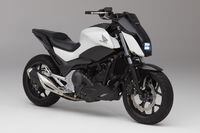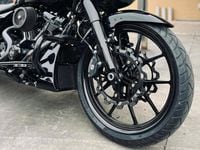Today at the Consumer Electronics Show in Las Vegas Honda showed a system it calls "Riding Assist Technology" which could assist riders in balancing bikes in the difficult low speed range below 3 mph. Nothing was said about when or even if such a system might appear in showrooms.
One video shows a bike sitting still with a rider aboard, self-balancing via fairly rapid steering inputs.
Another video reveals that levers move the front wheel and fork legs forward while keeping the steering pivot in its normal location, evidently giving the system increased leverage by which to affect balance.
Obviously, a fairly powerful steer actuator is used. In a third video, a smiling woman operates a switch atop the front fender (the motorcycle clearly has NC700-style inclined cylinders and an exhaust pipe), whereupon the machine, which has been self-balancing on a turntable, begins to follow her at walking pace through a building. This tells us that for demonstration purposes, the motorcycle is equipped with an electric drive and means of following a person or a specified course.
Honda has long had a department whose job it is to devise technologies such as the Asimo series of human-shaped robots, and the Uni-Cub mobility scooter, whose balance algorithms are said to be the basis of those used by Honda Riding Assist Technology (shall we call this “H-RAT”?).
In still photos, a similar machine is shown fitted with clamped-on support tripods on either side, intended to support the bike if the self-balancing system should lose power.
Unsaid in all of this is the implication that a machine equipped in this fashion has some attributes of an autonomous motorcycle. The urban owner of such a machine could notionally summon it from a garage when wanted, and send it back for secure storage after riding. Much more technology would clearly be required, as currently fitted to “driver assist” autos – obstacle detection, lane-keeping ability, and so on.
Uni-Cub (May 2012) and its predecessor mobility device U3-X (2009) make use of unique wheels whose tires consist of circular arrays of short cylindrical rollers. To move forward or back, the wheel rotates as a whole. To move sideways, its rollers are rotated to right or left. The user sits on the device, controlling it by leaning in the desired direction. Other mobility devices employing such concepts have been proposed as planetary rovers.
Clearly, Honda engineers assigned to such projects have a lot of fun and in the process discover many spinoffs. This same kind of free-wheeling engineering was behind the success of Bell Labs and IBM’s Thomas J. Watson Research Center.
Some may dismiss such activity as play because it is not tightly aimed at hitting the market by Friday. Shinichiro Kobashi, creator of Uni-Cub, says that device may be released at the time of the 2020 Tokyo Olympics. Play has special creative value because it can lead us away from traditional solutions to make surprising discoveries.
Noted Honda engineer Yoichi Oguma (now retired) has sometimes referred to “Honda’s refrigerator” – their collection of concepts without immediate application but having future potential too great to ignore. How long will that be the role of Riding Assist Technology?












/cloudfront-us-east-1.images.arcpublishing.com/octane/JXHJ2YSOXVCGLJNYHWNPTEBXEA.jpg)
/cloudfront-us-east-1.images.arcpublishing.com/octane/MBHCLQH34ZFJTEBJO4G6Z4EKOQ.jpg)
/cloudfront-us-east-1.images.arcpublishing.com/octane/6KWAL3TFNJBGTJMJSKQ2C6I3IY.jpg)
/cloudfront-us-east-1.images.arcpublishing.com/octane/GK5I5R3X7JCABGCKAKT4XY2K7U.jpg)


/cloudfront-us-east-1.images.arcpublishing.com/octane/RGUT3Y65IFGDFMLHQ3U7G5UUQE.jpg)

/cloudfront-us-east-1.images.arcpublishing.com/octane/37CSHD6CKRHYXHRB67EOLDS6XM.jpg)
/cloudfront-us-east-1.images.arcpublishing.com/octane/FYB7GKDGLVE3JKXMM75JTG2RYA.jpg)
/cloudfront-us-east-1.images.arcpublishing.com/octane/3ECVMM622VAZHIOLI6Q6ILWULU.jpg)


/cloudfront-us-east-1.images.arcpublishing.com/octane/UIZQ7VXRCRHBVDFK5RFJIEBBAU.jpg)

/cloudfront-us-east-1.images.arcpublishing.com/octane/QXBJ4CVEEBG2BF5O3TOPIGP7ZE.jpg)


/cloudfront-us-east-1.images.arcpublishing.com/octane/HGNDJUKK4FHNTP5XEYYHWVW6NI.jpg)
/cloudfront-us-east-1.images.arcpublishing.com/octane/GDGQOIQBDBCXLIUZUEMCP2C5ZE.jpg)
/cloudfront-us-east-1.images.arcpublishing.com/octane/M6Z3IHJEAZE4XDQGCFN7YPJEOA.jpg)
/cloudfront-us-east-1.images.arcpublishing.com/octane/L6GYTNOQB5FOXPUZIQZYQSJ3PI.jpg)
/cloudfront-us-east-1.images.arcpublishing.com/octane/FCGZHQXRBZFLBAPC5SDIQLVF4I.jpg)
/cloudfront-us-east-1.images.arcpublishing.com/octane/CWPFD2XJ6VHSJK3YMIJGHRJ5SA.jpg)
/cloudfront-us-east-1.images.arcpublishing.com/octane/4TTNZVVO6ZGN7AQUHVGHM4NFLQ.jpg)
/cloudfront-us-east-1.images.arcpublishing.com/octane/RXDCXNV46VFEVM4FNKCBPCTQXE.jpg)